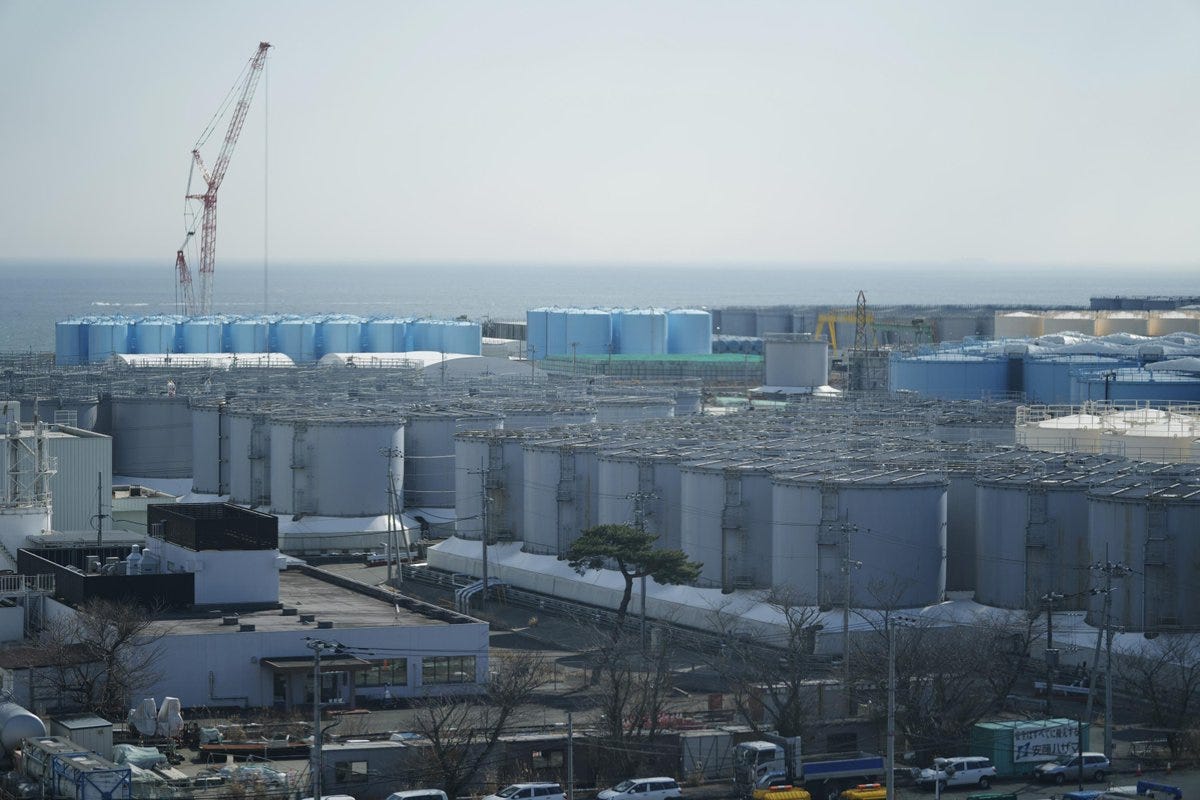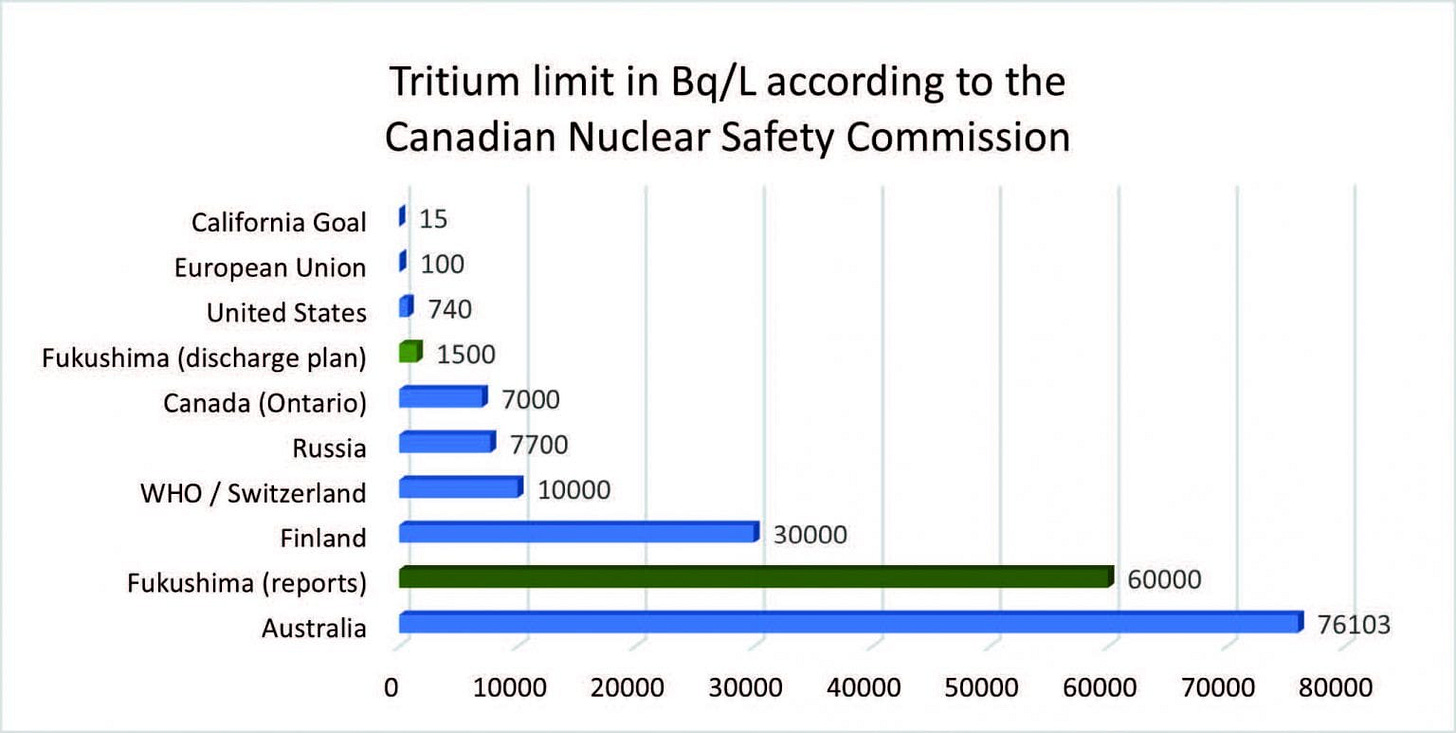Trivial Tritium
Correction: the email version of this piece claimed that natural production of tritium was 1000 times larger than nuclear production. This is incorrect. They are roughly the same. Mixing kilograms and grams. Mea culpa.
This piece assumes a bit of technical background. As usual, a longer, much better referenced version is at gordianknotbook.com.
Figure 1. Tritated water tanks at Fukushima.
Perhaps the most extreme example of the unnecessary problems the nuclear power establishment has created for itself --- and humanity and the planet --- is hydrogen-3 or tritium. It is hard to imagine a less dangerous radioactive isotope than tritium. Tritium has half-life of 12.3 years and emits an extremely weak electron, so weak it is stopped by a half-inch of air. Tritium radiation is so weak it cannot be measured by a normal Geiger counter. The electron is too weak to make it through the wall of the thinnest gas tight detector tube. A tritium electron cannot penetrate the dead outer layer of your skin. Each electron in a cathode-ray tube television has more energy. Tritium is used in self-illuminating road and runway signs, watches, rifle sights, and key chains.
Tritium is just hydrogen with two extra neutrons. Like ordinary hydrogen, it combines with oxygen to form water. In humans, water has a biological half life of 10 days. It's in and out in a couple of weeks. The only way tritium can possibly hurt you is if you drink such enormous quantities of tritium containing water that the water itself will be the health problem.
Tritium is everywhere. Cosmic rays produce 150,000,000,000,000,000 Bq per year in the upper atmosphere, much of which rains out into the surface waters we end up drinking. (Bq is short for radioactive decays per second.)
Tritated water is extremely difficult to separate from ordinary water. After Fukushima, the Japanese amassed over a million tons of contaminated water in the process of cooling the damaged reactors. At great expense, they have removed almost all the radioactive isotopes from this water. But about 6 grams of tritium remain. They've stored this water in hundreds of tanks spread over the plant. But now they are running out of space for new tanks, Figure 1.
The tritium content of this water is about 13 times above the Australian drinking water limit (76,000 Bq/liter) and about 1350 times the US legal limit (740 Bq/L).
Figure 2. Legal tritium drinking water limits vary by about a factor of 1000.
Since no harm has ever been observed from people drinking tritated water, nobody knows what the real health limit is. To get any response from mice, they had to be fed 37,000,000 Bq/L water. Figure 3 shows the factor of 1000 between any detectable harm and the Australian limit. The limits are really ALARA based. They are there because they are reasonably achievable.
Figure 3. Tritium detectable effects versus legal limits.
The obvious solution is to dump the 6 grams of tritium in the Pacific Ocean. Once this water was diluted by a factor of 15, it would be legal to drink in Australia. A factor of 1000 would make it legal just about everywhere. There are 660,000,000,000,000,000 m3 of seawater in the Pacific Ocean. Average seawater has a natural activity of about 12 Bq per liter, mostly from Potassium-40 which emits a penetrating photon, which is 250 times more powerful than the anemic tritium electron. However, spots with high salinity such as the Persian Gulf can be as high as 22 Bq/L. Dumping the 6 grams of tritium would increase the radioactivity of the Pacific Ocean by little more than two-ten-millionths.
Saltwater fish normally have a natural radioactivity of about 250 Bq/kg, mostly from Potassium-40. The biological half-life of tritium in fish and wildlife is about 2 days. Tritium does not concentrate up the food chain. Forget about harmful. No one would receive a measurable dose of tritium from this disposal. The solution is obvious. But the nuclear establishment's embrace of LNT and promulgation of ALARA has paralyzed us.
This has happened before. An innocuous tritium leak in 1997 at the Brookhaven National Lab combined with a panicked reaction by the DOE ended up shutting down a valuable medical and research reactor. A similar leak at the Vermont Yankee plant was critical in its premature decommissioning.
The Japanese have finally decided to start releasing the tritated water to the ocean; but they have done so in a way that will convince any reasonable observer that this is extremely dangerous material.
Tritium and New Nuclear
It is easy to make fun of the Japanese handling of the Fukushima tritium; but our fear of tritium is an important, pervasive problem for nuclear electricity. Tritium is about as difficult to contain as it is innocuous. Tritium is hydrogen. At elevated temperatures, hydrogen can worm its way through just about anything, even thick pipes. In practice, the nuclear power plant tritium emission limits are set by what is ``reasonably achievable" by a Light Water Reactor (LWR) operating normally. In other words, not by health considerations, but by what a Light Water Reactor can afford.
Non-LWR technologies operating at higher temperatures and with other materials produce 60 or more times as much tritium as a LWR of the same capacity. These same technologies promise totally passive safety and significant improvements in cost. But for them, achieving the LWR ALARA based levels can be as expensive as it is unnecessary. One of the new technologies is molten salt. Some molten salt designs include an additional loop in order to capture tritium. This adds totally unnecessary cost, complexity, inefficiency, and a whole new set of failure modes. And since tritium is so hard to contain, releases are inevitable.
Nuclear electricity has two choices:
1) Continue to accept unreasonable regulation and die.
2) Somehow convince the body politic to regulate nuclear power intelligently.
Tritium regulation is as unreasonable as it gets. So it's a good starting place, a good test. My advice to the developers of the non-LWR technologies is make your case to the regulators for reasonable limits on tritium, being prepared to walk. When he balks, take your case to the regulators' bosses, who presumably represent society as a whole, letting them know that if the regulator continues to be unreasonable, you will have to take your technology elsewhere. If you can't win this one, you are going nowhere.





This blanket statement is incorrect for workers at heavy water nuclear plants: “The only way tritium can possibly hurt you is if you drink such enormous quantities of tritium containing water that the water itself will be the health problem.”
The levels of tritium in air in some areas of an operating CANDU reactor can be in the thousands of MPCa (DAC), requiring air-supplied plastic suits to prevent large whole body radiation doses from inhaled and absorbed tritiated air. Ten hours unprotected exposure at 4000 MPCa would result in a whole body dose of 100 rem (1000 mSv) and likely acute radiation syndrome.
It is because high levels of tritium can cause acute and long term harm in this occupational setting, that tritium is continuously monitored, protective equipment is always required, and tritium uptake is regularly measured via urine sampling. As a result, no CANDU worker has ever received a tritium dose above the annual regulatory limit (5 rem / 50 mSv).
The solution to pollution is dilution!